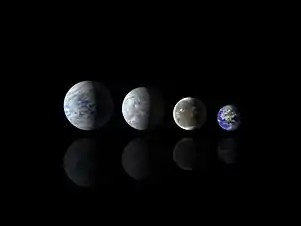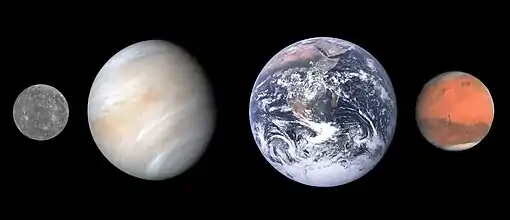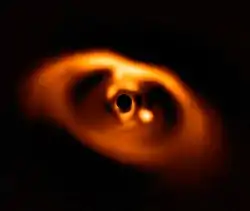Earth Similarity Index
The Earth Similarity Index (ESI) is a proposed characterization of how similar a planetary-mass object or natural satellite is to Earth. It was designed to be a scale from zero to one, with Earth having a value of one; this is meant to simplify planet comparisons from large databases. It has no quantitative meaning for habitability. Nonetheless, astronomers, in September 2020, identified 24 superhabitable planet (planets better than Earth) contenders, from among more than 4000 confirmed exoplanets at present, based on astrophysical parameters, as well as the natural history of known life forms on the Earth.[2]
Formulation
The ESI, as proposed in 2011 by Schulze-Makuch et al. in the journal Astrobiology, incorporates a planet's radius, density, escape velocity, and surface temperature into the index.[3] Thus the authors describe the index as having two components: (1) associated with the interior which is associated with the mean radius and bulk density, and (2) associated with the surface which is associated with the escape velocity and surface temperature. An article on the ESI formulation derivation is made available by Kashyap Jagadeesh et al.(2017) . ESI was also referenced in an article published in Revista Cubana de Física.[4]
For exoplanets, in almost every case only the planet's orbital period along with either the proportional dimming of the star due to the planet's transit or the radial velocity variation of the star in response to the planet is known with any degree of certainty, and so every other property not directly determined by those measurements is speculative. For example, while surface temperature is influenced by a variety of factors including irradiance, tidal heating, albedo, insolation and greenhouse warming, as these factors are not known for any exoplanet, quoted ESI values use planetary equilibrium temperature as a stand-in.[3]
A webpage maintained by one of the authors of the 2011 Astrobiology article, Abel Méndez at the University of Puerto Rico at Arecibo, lists his calculations of the index for various exoplanetary systems.[5] Méndez's ESI is calculated as
- ,
where and are properties of the extraterrestrial body and of Earth, respectively, is the weighted exponent of each property, and is the total number of properties. It is comparable to, and constructed from, the Bray–Curtis Similarity Index.[5][6] The weight assigned to each property, , are free parameters that can be chosen to emphasize certain characteristics over others or to obtain desired index thresholds or rankings. The webpage also ranks what it describes as the habitability of planets and moons according to three criteria: the location in the habitable zone, ESI, and a speculation as to a capacity to sustain organisms at the bottom of the food chain, a different index collated on the webpage identified as the "Global Primary Habitability scale".[7]
The 2011 Astrobiology article and the ESI values found in it received press attention at the time of the article's publication. As a result, Mars was reported to have the second-highest ESI in the Solar System with a value of 0.70.[8] A number of exoplanets listed in that article were reported to have values in excess of this, with Teegarden b reported to have the highest ESI[9] of confirmed exoplanets at 0.95.
Other ESI values that have been reported by third parties include:[8][5]
In next table, planets marked with * represents unconfirmed planet or planet candidate. Distances are from Earth Star system.
| Planet | ESI | Distance (ly) | Notes |
|---|---|---|---|
| Earth | 1.00 | 0 | |
| KOI-4878.01* | 0.98 | 1075 | unconfirmed but surface pressure may be 10atm at 292K, G4V-type Sun-like star |
| TRAPPIST-1e | 0.95 | 40 | likely tidally locked to star, surface pressure may be as little as 6atm at 285K, one of the most habitable known planets |
| Teegarden b | 0.95 | 12 | |
| Gliese 581 g* | 0.92 | 20 | unconfirmed, tidally locked to star, surface pressure may be 18atm at 284K |
| Luyten b | 0.91 | 12.2 | tidally locked to star, surface pressure may be 25atm at 294K |
| TRAPPIST-1 d | 0.91 | 40 | innermost habitable planet in TRAPPIST-1 system |
| Kepler-438b | 0.88 | 640 | temperature 276 K, likely tidally locked, habitability is uncertain |
| Proxima Centauri b | 0.87 | 4.2 | closest potentially habitable planet |
| Ross 128 b | 0.86 | 11 | host star is inactive and quiet, habitable if it has an Earth-like atmosphere |
| LHS 1723 b | 0.86 | 17.5 | lack of planet density or atmospheric data |
| Kepler-296 e | 0.85 | ~1820 | |
| Gliese 667 Cc | 0.85 | 23.62 | likely tidally locked to star, temperature is 277.4 K (4.3°C), based on black body temperature calculation |
| Kepler-442b | 0.84 | 1206 | it is in center of the habitable zone, temperature 233 K |
| Kepler-452b | 0.83 | 1402 | surface pressure may be 16-56atm at 288K with Helium if strong 587.5nm line. |
| Kepler-62e | 0.83 | 1200 | surface pressure may be 35atm at 288K with Helium if strong 587.5nm line. |
| Gliese 832 c | 0.81 | 16 | tidally locked, no plate tectonics, habitable if it has an Earth-like atmosphere |
| Kepler-283c | 0.79 | ~1527 | temperature is 238.5 K |
| HD 85512 b | 0.77 | 36 | if has an Earth-like atmosphere, without greenhouse effect |
| Wolf 1061c | 0.76 | 13.8 | |
| Gliese 667 Cf* | 0.76 | 23.6 | controversial existence |
| Kepler-440b | 0.75 | 850 | it has an elliptical orbit, temperature 273 K |
| HD 40307 g | 0.74 | 42 | |
| Kepler-61b | 0.73 | 1100 | |
| K2-18b* | 0.73 | 124 | temperature is 265 K, also known as EPIC 201912552 b |
| Gliese 581 d* | 0.72 | 20.4 | tidally locked to star |
| Kepler-22b | 0.71 | 587 | |
| Kepler-443b | 0.71 | 2540 | it has 89.9% chance of habitability, yet only 4.3% to be rocky |
| Gliese 422 b* | 0.71 | unconfirmed | |
| Mars | 0.70 | lacks global plate tectonics, too small for atmospheric water vapour | |
| TRAPPIST-1 f | 0.70 | 39 | temperature is 230 K, small chance to be rocky |
| Gliese 3293 c* | 0.70 | unconfirmed | |
| Kepler-62f | 0.69 | 990 | surface pressure may be 10atm at 288K with Helium if strong 587.5nm line |
| Teegarden c | 0.68 | 12 | |
| Kepler-298d | 0.68 | 1545 | |
| Kapteyn b | 0.67 | 12.8 | oldest known potentially habitable planet |
| Kepler-186f | 0.64 | 582 | potentially colder climate than Mars, but still habitable planet |
| Kepler-174d | 0.61 | ||
| Mercury | 0.60 | in 3:2 spin-orbital resonance to Sun | |
| Kepler-296f | 0.60 | ||
| Gliese 667 Ce* | 0.60 | 23.6 | controversial existence |
| HD 69830 d | 0.60 | 40.7 | lack of planet density or atmospheric data |
| TRAPPIST-1 g | 0.59 | 39 | largest planet in system, too cold to be habitable |
| Gliese 682 c* | 0.59 | unconfirmed | |
| 55 Cnc c | 0.56 | lack of planet density or atmospheric data | |
| Moon | 0.56 | too small for surface or atmospheric water, lacks plate tectonics | |
| 55 Cnc f | 0.53 | 41 | lack of planet density or atmospheric data |
| KOI-4427b* | 0.52 | unconfirmed | |
| Gliese 581b | 0.48 | it orbits within inner edge of habitable zone | |
| Venus | 0.44 | solar flux > Komabayasi-Ingersoll limit, slow retrograde rotation induced by Sun. | |
| Kepler-20f | 0.44 | 929 | |
| Gliese 1214b | 0.42 | 48 | it is probably ocean planet, temperature 390-552 K |
| Kepler-11b | 0.30 | ||
| Kepler-20e | 0.29 | ||
| Mu Arae e | 0.27 | ||
| Gliese 581 c | 0.24 | 20.37 | tidally locked to star |
| Kepler-20b | 0.24 | ||
| Neptune | 0.18 | Gas giant, blue color | |
| Gliese 581 e | 0.16 | 20.4 | tidally locked to star |
| K2-236b | 0.14 | 596 | |
| Jupiter | 0.12 | Gas giant | |
| Kepler-70c* | 0.03 | ||
No relation to habitability
Although the ESI does not characterize habitability, given the point of reference is the Earth, some of its functions match those used by habitability measures. As with the definition of the habitable zone, the ESI uses surface temperature as a primary function (and the terrestrial point of reference). A 2016 article uses ESI as a target selection scheme and obtains results showing that the ESI has little relation to the habitability of an exoplanet, as it takes no account of the activity of the star, planetary tidal locking, nor the planet's magnetic field (i.e. ability to protect itself) which are among the keys to habitable surface conditions.[9]
It has been noted that ESI fails to differentiate between Earth similarity and Venus similarity, as can be seen in the table above, where planets with a lower ESI have a greater chance at habitability.[10]
Planets with an Earth-like size

The classification of exoplanets is difficult in that many methods of exoplanet detection leave several features unknown. For example, with the transit method, one of the more successful measurement of radius can be highly accurate, but mass and density are often estimated. Likewise with radial velocity methods, which can provide accurate measurements of mass but are less successful measuring radius. Planets observed via a number of different methods therefore can be most accurately compared to Earth.
Similarity of non-planets to Earth

The index can be calculated for objects other than planets, including natural satellites, dwarf planets and asteroids. The lower average density and temperature of these objects give them lower index values. Only Titan (a moon of Saturn) is known to hold on to a significant atmosphere despite an overall lower size and density. While Io (a moon of Jupiter) has a low average temperature, surface temperature on the moon varies wildly due to geologic activity.[11]
References
- "HEC: Data of Potential Habitable Worlds".
- Schulze-Makuch, Dirk; Heller, Rene; Guinan, Edward (18 September 2020). "In Search for a Planet Better than Earth: Top Contenders for a Superhabitable World". Astrobiology. doi:10.1089/ast.2019.2161. Retrieved 5 October 2020.
- Schulze-Makuch, D.; Méndez, A.; Fairén, A. G.; von Paris, P.; Turse, C.; Boyer, G.; Davila, A. F.; Resendes de Sousa António, M.; Catling, D. & Irwin, L. N. (2011). "A Two-Tiered Approach to Assess the Habitability of Exoplanets". Astrobiology. 11 (10): 1041–1052. Bibcode:2011AsBio..11.1041S. doi:10.1089/ast.2010.0592. PMID 22017274.
- Gonzalez, A.; Cardenas, R. & Hearnshaw, J. (2013). "Possibilities of life around Alpha Centauri B.". Revista Cubana de Física. 30 (2): 81. arXiv:1401.2211. Bibcode:2014arXiv1401.2211G.
- "Earth Similarity Index (ESI)". Planetary Habitability Laboratory.
- Rushby, A. (2013). "A multiplicity of worlds: Other habitable planets". Significance. 10 (5): 11–15. doi:10.1111/j.1740-9713.2013.00690.x.
- Sample, I. (December 5, 2011). "Habitable exoplanets catalogue ranks alien worlds on suitability for life". The Guardian. Retrieved April 9, 2016.
- "Most liveable alien worlds ranked". BBC. November 23, 2011. Retrieved April 10, 2016.
- Armstrong, D. J.; Pugh, C. E.; Broomhall, A.-M.; Brown, D. J. A.; Lund, M. N.; Osborn, H. P.; Pollacco, D. L. (2016). "The host stars of Kepler's habitable exoplanets: superflares, rotation and activity". Monthly Notices of the Royal Astronomical Society. 5 (3): 3110–3125. arXiv:1511.05306. Bibcode:2016MNRAS.455.3110A. doi:10.1093/mnras/stv2419.
- Elizabeth Tasker (July 9, 2014). "No, that new exoplanet is not the best candidate to support life". The Conversation. Retrieved November 5, 2018.
- Keszthelyi, L.; et al. (2007). "New estimates for Io eruption temperatures: Implications for the interior". Icarus. 192 (2): 491–502. Bibcode:2007Icar..192..491K. doi:10.1016/j.icarus.2007.07.008.

